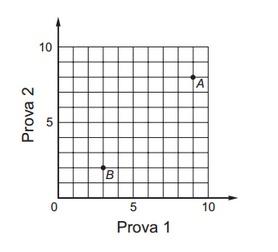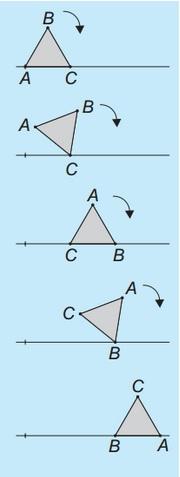Mix Questões Prova Obmep Anos 2013/2014

- 1.
(OBMEP 2014 - Nível 1 - Fase 1- Questão 7) A figura é formada por dois quadrados, um de lado 8 cm e outro de lado 6 cm. Qual é a área da região cinza?
- A.
44 cm²
- B.
46 cm²
- C.
48 cm²
- D.
50 cm²
- E.
56 cm²
Correct Answer
A. 44 cm²Explanation
The figure consists of two squares, one with a side length of 8 cm and the other with a side length of 6 cm. The gray region is the difference between the area of the larger square and the smaller square. The area of the larger square is 8 cm * 8 cm = 64 cm², and the area of the smaller square is 6 cm * 6 cm = 36 cm². Therefore, the area of the gray region is 64 cm² - 36 cm² = 28 cm². However, the given options do not include 28 cm², so the closest option is 44 cm².Rate this question:
-
- 2.
(OBMEP 2013 - Nível 1 - Fase 1- Questão 8) Beatriz e André foram almoçar juntos em um restaurante e cada um escolheu um prato e uma bebida. André gastou R$ 9,00 a mais do que Beatriz. Qual foi o almoço de André?
- A.
Prato completo e suco de manga
- B.
Prato simples e vitamina
- C.
Prato especial e suco de laranja
- D.
Prato simples e suco de laranja
- E.
Prato especial e suco de manga
Correct Answer
E. Prato especial e suco de mangaExplanation
Since André spent R$ 9,00 more than Beatriz, we can eliminate the options with a "prato simples" (simple dish) since they are cheaper. Among the remaining options, the only one that includes a "prato especial" (special dish) is the combination of a special dish and mango juice. Therefore, the correct answer is "prato especial e suco de manga" (special dish and mango juice).Rate this question:
-
- 3.
(OBMEP 2014 - Nível 1 - Fase 1- Questão 2) Um grupo de 14 amigos comprou 8 pizzas. Eles comeram todas as pizzas, sem sobrar nada. Se cada menino comeu uma pizza inteira e cada menina comeu meia pizza, quantas meninas havia no grupo?
- A.
12
- B.
10
- C.
8
- D.
6
- E.
4
Correct Answer
A. 12Explanation
There were 12 girls in the group. Since each boy ate a whole pizza and each girl ate half a pizza, the total number of pizzas eaten would be 14 (boys) + 12 (girls x 0.5) = 14 + 6 = 20. However, there were only 8 pizzas, so the remaining 12 pizzas must have been eaten by the girls. Therefore, there were 12 girls in the group.Rate this question:
-
- 4.
(OBMEP 2014 - Nível 2 - Fase 1- Questão 16) A mãe de Lúcia pediu para ela não comer mais de 10 docinhos por dia. Além disso, se em um dia ela comer mais de 7 docinhos, nos dois dias seguintes não poderá comer mais de 5 docinhos em cada dia. Qual é o maior número de docinhos que Lúcia pode comer durante um período de 29 dias seguidos, obedecendo ao pedido de sua mãe?
- A.
203
- B.
204
- C.
206
- D.
213
- E.
290
Correct Answer
C. 206Explanation
Lúcia can eat a maximum of 206 candies in a period of 29 consecutive days while obeying her mother's request. This can be achieved by eating 10 candies for the first 7 days, then 7 candies for the next 7 days, and finally 5 candies for the remaining 15 days. This way, Lúcia will not exceed 10 candies in a single day and will also not exceed 7 candies in any given day, followed by two days with a maximum of 5 candies each.Rate this question:
-
- 5.
(OBMEP 2013 - Nível 3 - Fase 1- Questão 1) O pai de Carolina mediu o comprimento da mesa da sala com sua mão e contou 8 palmos. Ela também mediu a mesa do mesmo modo e contou 11 palmos. Qual é o tamanho do palmo de Carolina, se o palmo de seu pai mede 22 centímetros?
- A.
19 cm
- B.
16 cm
- C.
14 cm
- D.
13 cm
- E.
12 cm
Correct Answer
B. 16 cmExplanation
Carolina's father measured the length of the table using his hand and counted 8 palms. Carolina also measured the table in the same way and counted 11 palms. If her father's palm measures 22 centimeters, then each palm of Carolina must be equal to 22 centimeters divided by the difference in the number of palms counted by both of them. In this case, the difference is 11 - 8 = 3 palms. Therefore, the size of Carolina's palm is 22 centimeters divided by 3, which is equal to 7.33 centimeters. Since the answer options are given in whole numbers, the closest option to 7.33 centimeters is 16 centimeters.Rate this question:
-
- 6.
(OBMEP 2013 - Nível 3 - Fase 1- Questão 3) O gráfico mostra o número de casos notificados de dengue, a precipitação de chuva e a temperatura média, por semestre, dos anos de 2007 a 2010 em uma cidade brasileira. Podemos afirmar que:
- A.
Quanto maior a precipitação em um período, maior o número de casos de dengue notificados.
- B.
O período de maior precipitação não foi o de maior temperatura média e teve o maior número de casos de dengue notificados.
- C.
O período de maior temperatura média foi também o de maior precipitação.
- D.
O período com menor número de casos de dengue notificados também foi o de maior temperatura média.
- E.
O período de maior precipitação foi o de maior temperatura média e com o maior número de casos de dengue notificados.
Correct Answer
B. O período de maior precipitação não foi o de maior temperatura média e teve o maior número de casos de dengue notificados.Explanation
The correct answer states that the period with the highest precipitation was not the one with the highest average temperature, but it had the highest number of reported dengue cases. This suggests that there may be other factors influencing the occurrence of dengue cases, such as stagnant water caused by heavy rainfall, which creates breeding grounds for mosquitoes that transmit the disease. Therefore, the statement implies that precipitation plays a significant role in the increase of dengue cases, regardless of the temperature.Rate this question:
-
- 7.
(OBMEP 2013 - Nível 3 - Fase 1- Questão 13) Durante a aula, dois celulares tocaram ao mesmo tempo. A professora logo perguntou aos alunos: “De quem são os celulares que tocaram?” Guto disse: “O meu não tocou”, Carlos disse: “O meu tocou” e Bernardo disse: “O de Guto não tocou”. Sabe-se que um dos meninos disse a verdade e os outros dois mentiram. Qual das seguintes afirmativas é verdadeira?
- A.
Guto falou a verdade.
- B.
Carlos mentiu.
- C.
Os celulares de Guto e Carlos não tocaram.
- D.
Bernardo mentiu.
- E.
O celular de Carlos tocou e o de Guto não tocou.
Correct Answer
D. Bernardo mentiu.Explanation
Based on the given statements, we can deduce that one of the boys is telling the truth while the other two are lying. Guto says his phone didn't ring, Carlos says his phone rang, and Bernardo says Guto's phone didn't ring. If Guto's phone didn't ring, then Carlos must be lying because he said his phone rang. This means that Bernardo is telling the truth when he says Guto's phone didn't ring. Therefore, the correct answer is "Bernardo mentiu" (Bernardo lied).Rate this question:
-
- 8.
(OBMEP 2014 - Nível 3 - Fase 1- Questão 4) Guilherme precisa chegar em 5 minutos ao aeroporto, que fica a 5 km de sua casa. Se nos 2 primeiros minutos seu carro andar a uma velocidade média de 90 km/h, qual é a menor velocidade média que ele terá que desenvolver nos próximos 3 minutos para não chegar atrasado ao aeroporto?
- A.
60 km/h
- B.
50 km/h
- C.
45 km/h
- D.
40 km/h
- E.
35 km/h
Correct Answer
D. 40 km/hExplanation
Guilherme needs to reach the airport in 5 minutes, which is 5 km away from his house. In the first 2 minutes, his car travels at an average speed of 90 km/h. To calculate the minimum average speed he needs to maintain for the next 3 minutes, we can use the formula: average speed = total distance / total time. In this case, the total distance is 5 km and the total time is 5 minutes. Since he already spent 2 minutes traveling at 90 km/h, he has 3 minutes left. So, the average speed for the remaining 3 minutes should be (5 km - 90 km) / 3 minutes = 40 km/h. Therefore, the correct answer is 40 km/h.Rate this question:
-
- 9.
(OBMEP 2014 - Nível 3 - Fase 1- Questão 9) O professor Michel aplicou duas provas a seus alunos e divulgou as notas por meio do gráfico mostrado abaixo. Por exemplo, o aluno A obteve notas 9 e 8 nas provas 1 e 2, respectivamente; já o aluno B obteve notas 3 e 2. Para um aluno ser aprovado, a média aritmética de suas notas deve ser igual a 6 ou maior do que 6. Qual dos gráficos representa a região correspondente às notas de aprovação?
- A.
.
- B.
.
- C.
.
- D.
.
- E.
.
Correct Answer
E. . -
- 10.
(OBMEP 2014 - Nível 3 - Fase 1- Questão 18) Um triângulo equilátero ABC gira uma vez em torno do vértice C e outra vez em torno do vértice B, sempre se apoiando em uma reta, como na figura ao lado. Qual das alternativas representa a trajetória descrita pelo ponto A?
- A.
.
- B.
.
- C.
.
- D.
.
- E.
.
Correct Answer
A. . -
Quiz Review Timeline +
Our quizzes are rigorously reviewed, monitored and continuously updated by our expert board to maintain accuracy, relevance, and timeliness.
-
Current Version
-
Mar 21, 2023Quiz Edited by
ProProfs Editorial Team -
May 08, 2015Quiz Created by
Gustavo_rk
 Back to top
Back to top






